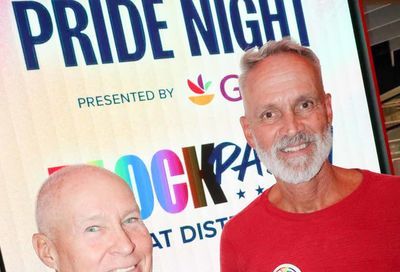Meth by the Numbers
First community-based survey regarding crystal methamphetamine use offers a 'glimpse' of local usage
Thomas McDermitt was battling addiction long before discovering ”crystal.”
In the five years since graduating from high school in 1986, McDermitt outgrew his alcohol addiction in exchange for ecstasy, heroin and unprotected sex, which resulted in an HIV-positive diagnosis in 1991.
Even that didn’t derail his addiction for more.
And he found more with crystal methamphetamine, the drug that by the late ’90s had become popular among many gay men in Washington.
”I had heard of it before but I had never seen it,” McDermitt told a roomful of about 50 attendees of a town-hall meeting organized by the D.C. Crystal Meth Working Group (DCCMWG), a coalition of concerned citizens and community organizations including The D.C. Center, Whitman-Walker Clinic and others, on Thursday, Nov. 29, at the city’s Frank D. Reeves Center at 14th and U Streets NW.
McDermitt told his tale of addiction to commemorate National Methamphetamine Awareness Day. The primary function of the meeting was, however, to present data acquired from the first community-based survey regarding the use of crystal methamphetamines among D.C.-area residents. But McDermitt’s tale had more traction.
”I did it…and when that high hit me, I knew I had found my drug of choice. I knew there was nothing else in the world that I wanted to do,” said McDermitt, who now lives in Wernersville, Pa., but who used to frequent Washington’s nightlife while living in West Virginia.
Even a life-threatening car accident, which occurred when McDermitt fell asleep behind the wheel in February 1995 and resulted in an extended withdrawal period, wouldn’t keep him from his new drug of choice.
”As soon as I got off the crutches, I got right back in with the club scene again…and when I picked up meth, my addiction went into a different direction than it had ever gone before,” McDermitt admitted, explaining that he entered into crystal methamphetamine addiction by snorting or smoking the drug.
”I injected crystal meth for the first time… and when that needle went into my arm and I felt that hit, I knew that my addiction and my life had gone into a direction that I knew there was no turning back. There was only one way to do meth, and that was to shoot it. And I did it through the spring of 1995 and into the summer, and my life completely fell apart.”
McDermitt has come a long way over the past 12 years. In March 2004, after visiting Caron, an HIV/AIDS retreat center in Wernersville, he took a 65 percent pay cut to work at Caron as administrator to adolescent youth battling drug addictions.
”To treat meth addicts is totally different than treating anybody else,” he said. ”Thirty days is good, 60 days is better, 90 days is fantastic. But I truly believe…six months to a year of inpatient treatment is what you need [before] transitioning to a halfway house with a strong support group. The relapse rate is unbelievable for crystal meth.”
Though McDermitt’s story seems to have found its hopeful end, the DCCMWG’s survey work may have just begun.
”We think that with doing this survey, we didn’t find the highest-risk groups of people,” said Kristen Degan, chair of the DCCMWG’s data and survey subcommittee. ”We plan to do another round with the survey, using this exact same survey, but going to nightclubs, putting it online, and going to bathhouses, so that we can find people who may be at higher risk for using crystal meth. We don’t think we found everybody we were looking for, using this survey at the [Pride events].”
Of the 1,109 D.C.-area residents who took part in the 14-question survey, administered at 2007’s Black Pride, Capital Pride and Adams Morgan Day events, 87 people said they had used crystal meth, and 988 said they had not.

Michael Sessa
The DCCMWG shared the rough breakdown of the 87 surveyed crystal meth users: The majority were between 20-39 years of age; 93 percent were gay, lesbian or bisexual; 69 percent identified as white male; 23 percent were HIV-positive; and 67 percent used other illegal drugs in the past.
”We need to increase our outreach to non-users and concerned family and friends, as well as to the users,” Degan said. ”We need to get the word out on where you can go for help, and what resources exist here in D.C.”
According to survey results, 81 percent of overall respondents did not know where to go for help in dealing with crystal meth addiction.
Michael Sessa, chair of the DCCMWG and president of The D.C. Center, says the results do not represent D.C.’s entire population, but rather a ”glimpse” of who is using the drug and why.
”It didn’t start with us, and it may not end with us, but we know we have the ability to make a positive impact on this topic.”
For more information about the D.C. Crystal Meth Working Group visit www.letstalkaboutmeth.org.
Support Metro Weekly’s Journalism
These are challenging times for news organizations. And yet it’s crucial we stay active and provide vital resources and information to both our local readers and the world. So won’t you please take a moment and consider supporting Metro Weekly with a membership? For as little as $5 a month, you can help ensure Metro Weekly magazine and MetroWeekly.com remain free, viable resources as we provide the best, most diverse, culturally-resonant LGBTQ coverage in both the D.C. region and around the world. Memberships come with exclusive perks and discounts, your own personal digital delivery of each week’s magazine (and an archive), access to our Member's Lounge when it launches this fall, and exclusive members-only items like Metro Weekly Membership Mugs and Tote Bags! Check out all our membership levels here and please join us today!





















